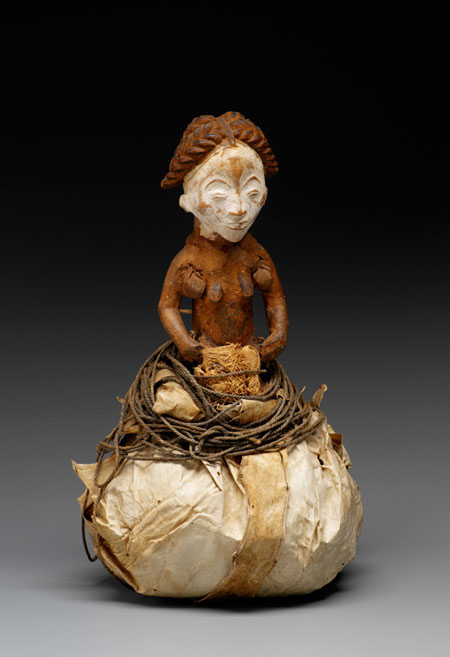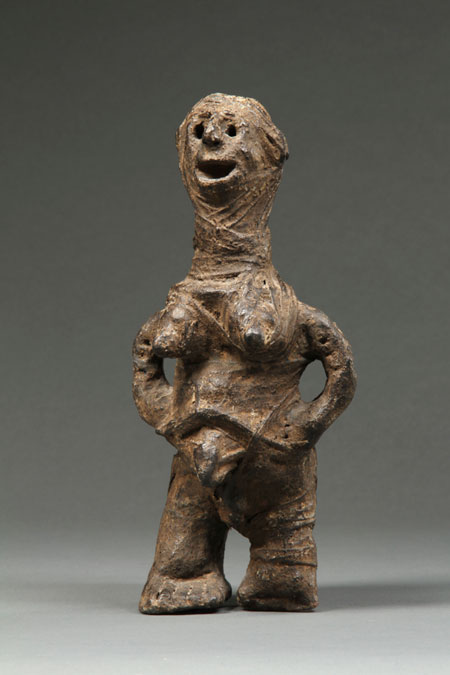|

Earth. The ancestors are buried in it. Healing materials come from it. It is a home to the sacred. In Africa-like Europe, the Americas, and Asia-individuals live, work, and frame their days upon land. It is a source of power. This power can be packed onto sculpture, rubbed onto canvas or mylar, molded into new forms, or tied and bundled together. Each strategy conveys a particular set of associations, from healing to the ability to dispel negative stereotypes.
|

Teke artist, Republic of the Congo
Buti or nkiba (healing figure)
Late 19th to early 20th century
Wood, accumulative material
National Museum of African Art, acquisition grant from the James Smithson Society and museum purchase, 90-2-1
Healing with earth. During at least the 19th and 20th centuries, Teke men made wood figures with cavities into which healing materials were inserted and around which earth and other medicines were packed. Such figures were produced at precisely the time when the Teke peoples lost their territories because of colonization.
White chalk is among the inserted "earths" and connected the figures to the land (and bones) of the ancestors. The wrappings and elephant hairs on the figure on the right [acc. no. 73-7-399] most likely conceal and protect its earthen medicines. Each figure was kept inside a man's home upon a mound of sand or dirt so as always to touch the earth.
|

Punu artist, Gabon
Reliquary ensemble: female half-figure
19th century
Wood, kaolin pigments, hide, vegetable fiber, relics, organic matter
Musée du Quai Branly, Paris, France, 71.1943.0.433
Bundling earth and ancestors. Earthen materials join stunning statuary and the bones of important forebears to honor the ancestors and educate new generations in the remarkable reliquary arts of Gabon. Small sachets of red laterite, tucked beneath each arm of an exquisitely carved, one-of-a-kind Punu reliquary, aided the living in communicating with their honored dead. Gleaming copper-also known as "red gold"-on a Sango reliquary may have served a similar function. Fang men rubbed the sacra of their honored ancestors with red earthen pigments and stored red ocher and chalk in bark boxes guarded by evocatively carved heads and muscular figures. Earthen pigments and copper likely facilitated communication between the living and their ancestors, and their powers were combined in a robust 19th-century Fang reliquary figure.
|
Tchif
b. 1973, Republic of Benin
Sunshine Land
2012
Oil, earthen pigments, and cord on canvas
Collection of the artist
Binding past and present to the earth. Based in Cotonou, Benin, the painter Tchif incorporates thick applications of earthen pigments onto his canvases that build up, crack, and are rubbed away to create a rich topography. Tchif considers each painting to be "a piece of land to which the soul is attached." He uses string in a conscious reference to bocio and the sacred arts of Vodun. For Tchif, cords evoke the "link between the living and the hereafter, and the origin of the world-the umbilical cord."
|

Pare or Zigua artist, Tanzania
Figure
Date unknown (most likely 19th to early 20th century)
Terracotta, fabric, fibers, resin
Collection of Robert T. Wall Family, W-0450
Bound to Heal. Tying, or "closing off," is an aesthetic strategy employed by healers in the related Zigua, Pare, and Shambala communities of Tanzania to prevent the spread of negative powers. This practice is likely related to the history of slavery in east Africa. Enslaved men and women forced from their land were bound; now these strategies are used to tie members of these communities to their land and its healing properties. Both gourds and the more rare figures used in healing arts are wrapped, bound, and tied with cords, hide, and string.
|

Berry Bickle
b. 1959, Zimbabwe
Sarungano
2001
Mixed media on mild steel
National Museum of African Art, museum purchase with funds provided by the Kellogg Foundation, 2005-3-1
Healing history with salt and sand. Ten sheets of mild steel have been burned, rubbed, and added to until they take on a patina of weathered earth. Inscribed into this surface are the words of William Shakespeare's Sonnet 66, which countless Zimbabwean children were required to learn. Berry Bickle juxtaposes Shakespeare's words concerning moral and social injustice with spoons, shoes, and other personal effects of the type found on graves in Zimbabwe. She filled these items with salt to acknowledge the pain her compatriots have suffered and sand to help with their release from earthly suffering.
|

Ledelle Moe
b. 1971, South Africa
Land/Displacements
2012-13
Concrete, iron
Collection of the artist
Made of earth. Now based in Baltimore, South African sculptor Ledelle Moe uses South African soil as an aggregate to infuse and color her concrete sculptures with the substance of her homeland. In this new body of work, she explores themes of landscape and migration. She has fused together aspects of the landscape between Cape Town and Durban and added to the surface figures that flow like water or birds across her boulderlike formations.
|
|
|





